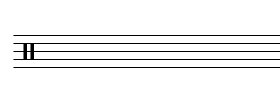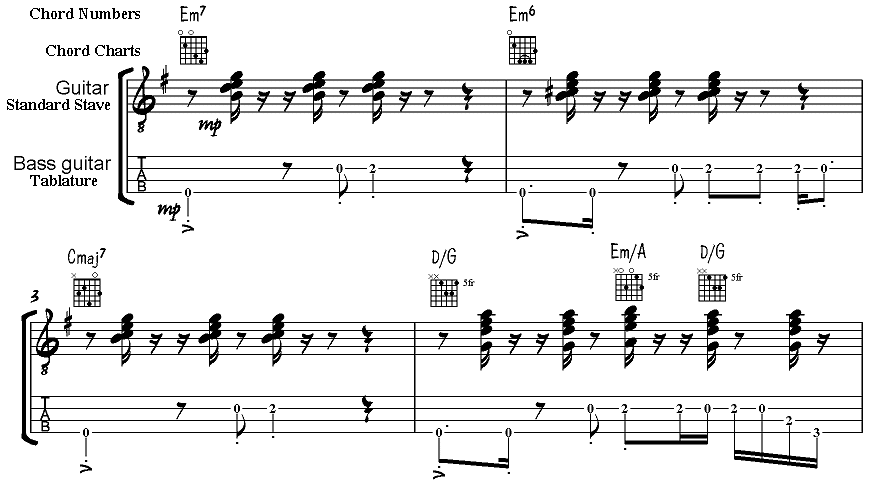The family of instruments called percussion instruments is large. It includes instruments that are sounded by striking, shaking, plucking or scraping. All instruments such as drums and bells fall into this category. Percussion instruments may be further divided into those instruments that produce a definite pitch and those that do not. Some whistles (aerophones) are also included in this category because they are considered to be 'sound effects'.
Table of Common Percussion Instruments | ||||
Tuned Percussion | Untuned Percussion | Auxillary Percussion | Latin Percussion | Drum Kit |
Antique Cymbals | Bass Drum | Acme Siren (Police Siren) | Agogo Bells | Kick Drum |
Indeterminate pitch percussion parts are written on staves that may have anything from one to five lines.

On the five line stave shown above each line and each space is ascribed to a different percussion instrument. Different effects may also be indicated by a range of note heads, x, standard, open diamond, closed diamond, +, filled triangle, etc. For our purposes here we are going to use our own convention, very similar to that used by other writers, which is as follows:
| Position | Instrument |
| 1 leger-line above staff | triangle |
| Space above top line | x note head: closed hi-hat open diamond note head: open hi-hat |
| Top line | ride cymbal |
| Top space | small tom-tom |
| 2nd line from top line | woodblock |
| 2nd space from top space | snare drum |
| Middle line | small suspended cymbal |
| 3rd space from top space | large tom-tom |
| 4th line from top line | large suspended cymbal |
| Bottom space | bass drum |
| Bottom line | high bongo |
| Space below bottom line | electric snare |
| 1 leger-line below staff | low bongo |
We give an exmple of a standard drum pattern below.
| Percussion - 1 |
This pattern is an 8th feel pattern, also called a disco pattern. There are many books offering written-out drum patterns which aspiring drummers will need to have at their 'finger tips'. This lesson is not about the art of drumming and so we give only a few common patterns. The disco pattern is a fairly sedate four-in-a-bar, with the hi-hat providing the quaver or 8th note feel. Introducing more notes into the beat is one way of increasing the tension in the drum line without necessarily increasing the speed of the basic pulse. We illustrate this below.
| Percussion - 2 |
The 'fizz' generated by the hi-hat cymbals can be made even more effective by playing a continuous semiquaver (16th note) line (this is called variously 16ths feel or motown) over a number of different drum patterns. We illustrate this with eight bars, each two a different drum pattern, but all suffused with the hi-hat semiquavers (16th notes).
| Percussion - 3 |
Shuffle patterns 'swing' the rhythm as the following examples demonstrate. Notice how the third and fourth examples are 'half-time' patterns, the basic beat dropping from 4 in a bar to 2 in a bar.
| Percussion - 4 |
'Triplet feel' may look similar to swing and shuffle except that the tempo is much slower.
| Percussion - 5 |
This is but one example of how patterns have a very different feel depending on the speed of the underlying pulse. This becomes very important when considering drum patterns to dance rhythms like the beguine, the bossanova, the mambo, the paso doble, the rhumba, the samba and waltz. Some of these have a very narrow range of acceptable tempi while others, like the rhumba, are robust enough to work for a wide range of speeds. We have combined all these dance rhythms in one example below.
| Percussion - Dances |
By concentrating on the drum line some important rhythmic details can be overlooked. While in some situations the bass guitar line matches the drum line, in other cases it becomes an additional detail in the rhythmic line. The rhumba is a perfect example and we show below a rhythm line without bass and then the same line but with a standard bass guitar line.
| Percussion - Rhumba |
Modern bass guitar playing has developed greatly over the last twenty years with exciting new sounds. This is a subject better explored at specialist bass guitar web sites. We would however include an example taken from lesson 30 in which the bass guitar line is clearly performing a role more commonly undertaken by the drummer.

Reference:
- Drum Lessons Database
- African Drumming Rhythms
- Anatomy of the Drumstick
- The Making of Timpani Sticks
 :: next lesson
:: next lesson